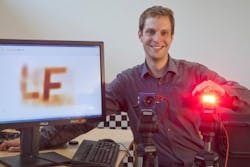Time-of-flight camera uses diffuse light to see around corners

Scientists from the Universität Bonn (Bonn, Germany) and the University of British Columbia (UBC; Vancouver, Canada) have developed a novel camera system that effectively turns a diffusely reflecting wall into a mirror, allowing around-the-corner imaging.1 The technique uses second-order reflections (twice-reflected light).
Based on a modulated light source, the setup is a time-of-flight image-sensing system that has a resolution on the order of a few centimeters in the lateral and axial directions, and can also determine the albedos of various around-the-corner objects in large room-sized scenes.
The approach has some similarities with an ultrafast around-the-corner imaging technique developed at the Massachusetts Institute of Technology (MIT; Cambridge, MA), but the Bonn/UBC approach uses much-less-expensive time-of-flight hardware.
The Bonn/UBC researchers will be reporting their results at the international Conference for Computer Vision and Pattern Recognition (CVPR) held from June 24-27, 2014 (Columbus, OH).
The system projects a laser dot on a wall; the dot serves as a light source. Some of this light, in a roundabout way, is reflected off objects back to the wall and finally into the camera. "We are recording a kind of light echo, that is, time-resolved data, from which we can reconstruct the object," says Matthias Hullin, a Universität Bonn researcher.
The technical complexity for this is comparatively low: suitable time-of-flight image sensors came onto the mass market long ago. The actual challenge is to elicit the desired information from such time-of-flight measurements. Hullin compares the situation to a room which reverberates so greatly that one can no longer have a conversation with one's partner. "In principle, we are measuring nothing other than the sum of numerous light reflections which reached the camera through many different paths and which are superimposed on each other on the image sensor."
Dealing with multipath interference
This problem, known as multipath interference, has been giving engineers headaches for a long time. Traditionally, one would attempt to remove the undesired multipath scatter and only use the direct portion of the signal. Based on an advanced mathematical model, Hullin and his colleagues, however, developed a method that can obtain the desired information exclusively from what would usually be considered noise rather than signal.
"The accuracy of our method has its limits, of course," says Hullin. However, the researchers assume that based on the rapid development of technical components and mathematical models, an even higher resolution can be achieved soon.
Source: http://www.alphagalileo.org/ViewItem.aspx?ItemId=142806&CultureCode=en
REFERENCE:
1. Felix Heide et al., in "Proceedings of IEEE Conference on Computer Vision and Pattern Recognition (CVPR)," pages to appear June 2014; see http://cg.cs.uni-bonn.de/en/publications/paper-details/HeideCVPR2014/
About the Author
John Wallace
Senior Technical Editor (1998-2022)
John Wallace was with Laser Focus World for nearly 25 years, retiring in late June 2022. He obtained a bachelor's degree in mechanical engineering and physics at Rutgers University and a master's in optical engineering at the University of Rochester. Before becoming an editor, John worked as an engineer at RCA, Exxon, Eastman Kodak, and GCA Corporation.
